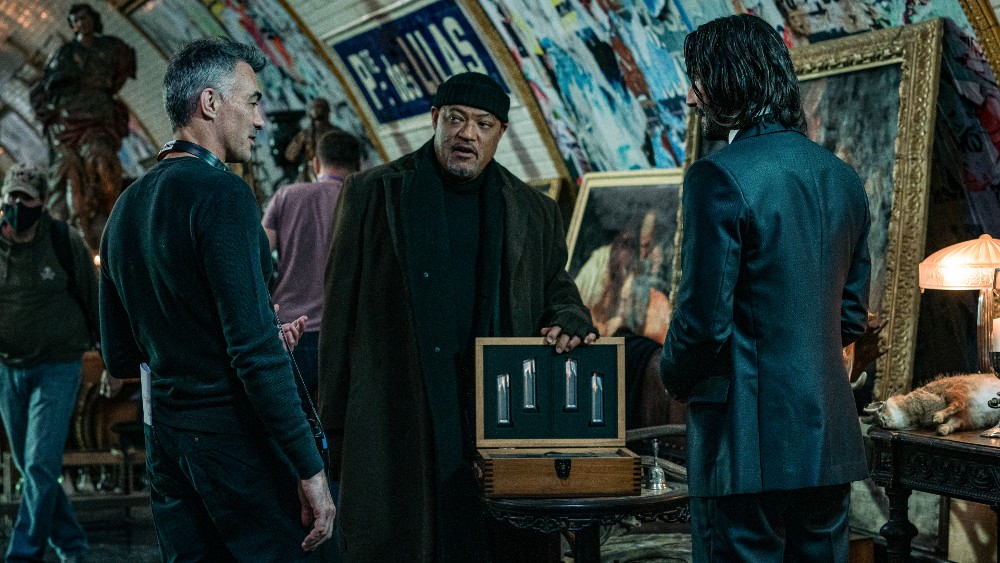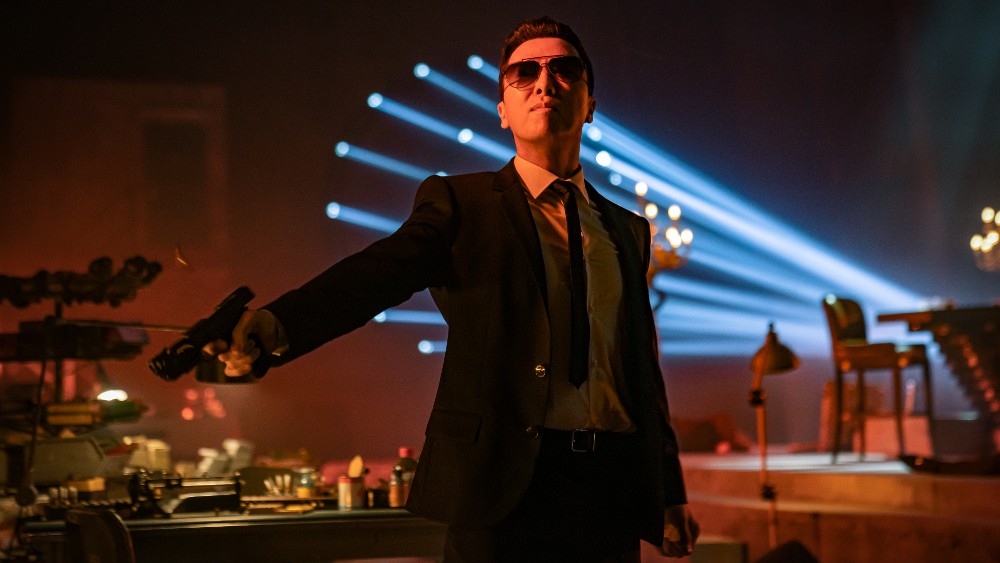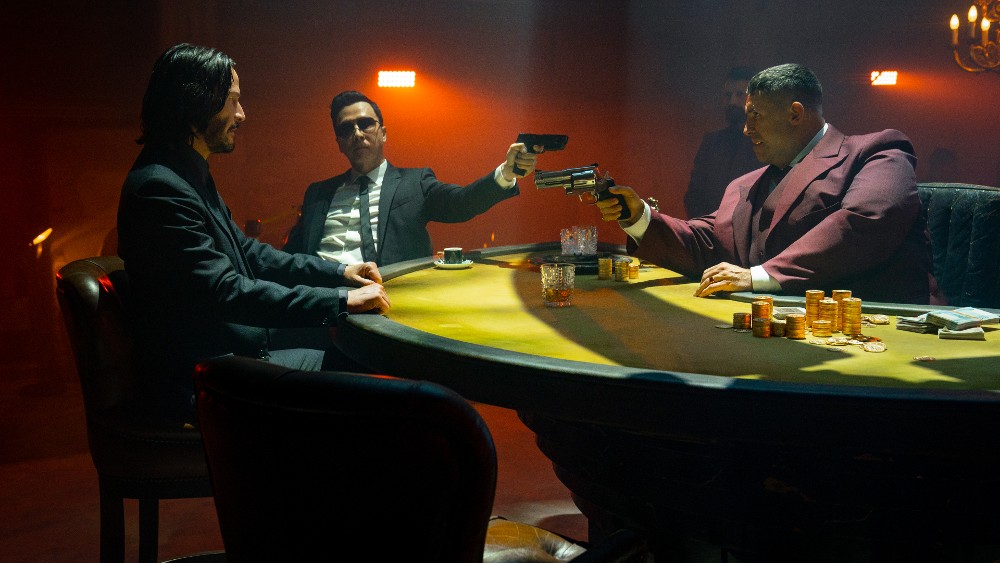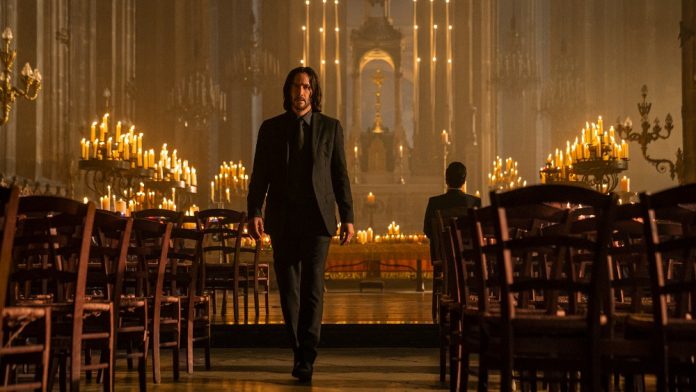For over 20 years, Chad Stahelski was one of Hollywood’s go-to stunt coordinators, having worked on The Hunger Games and The Matrix trilogy, often doubling for its star, Keanu Reeves. When Stahelski chose to make his feature directorial debut with 2014’s John Wick alongside David Leitch, he may not have realized how ensconced he would be in that ever-growing world over the course of the next decade, as the film became a surprise hit.
This week brings the release of Stahelski’s fourth film, appropriately titled John Wick: Chapter 4, and the world surrounding Reeves’ former assassin has grown to a suitably global scale. Wick is still on the run from the cadre of assassins who want to kill him for the massive bounty on his head, but this time they’re joined by Donnie Yen‘s blind assassin, Caine; a mysterious entity known as The Tracker (Shamier Anderson), who travels with his dog; and the Marquis (Bill Skarsgård), who heads “The High Table,” which is in charge of the franchise’s entire network of assassins.
Chapter 4 begins with the Marquis making his presence known at New York’s Continental — imagine a Soho House for assassins — and decommissioning it due to the aid that its manager, Winston (Ian McShane) gave to John Wick, who has since gone to the Osaka Continental in Japan seeking refuge from that hotel’s manager, played by local legend Hiroyuki Sanada. It’s not long before Wick is discovered and all hell breaks loose. The sequel also travels to Germany and France, where some of the local landmarks play home to the kind of jaw-dropping action for which the franchise has earned its reputation.
Above the Line recently spoke with Chad Stahelski over Zoom for the following interview, in which he discussed many different aspects of making John Wick: Chapter 4, though it was conducted just before the tragic passing of actor Lance Reddick, who has played Charon in all four films, just in case you’re wondering why that’s not addressed below. R.I.P.

Above the Line: I’d like to go back a little bit because when you and David Leitch made the first movie, I’m curious whether [screenwriter] Derek Kolstad had given you some idea of the bigger world around Wick. It was slightly set up there, but that world just got bigger and bigger with each movie.
Chad Stahelski: Remember, we were a very small movie at the time. We had to shoot that whole thing in record time, we had no time for the action. In [Derek’s] original script, John Wick was much older. He was a Cold War veteran. It was a much more grounded film. I think that the body count was, like, three. I think it was very small and very grounded — a very serious thriller-esque kind of thing. He had a little bit of the gold coins, but his reasoning was [that] during the Cold War, gold was untraceable. He did have hints of the Continental as a sacred place for old Cold War veterans where no business was [conducted].
What we did is, we came in, and I’m a big fan of Greek mythology and [J.R.R.] Tolkien and that kind of thing, and we wanted to somehow create a modern-day fantasy kind of thing. Instead of swords, we had guns, and instead of the hidden gods, we had the Continentals, with Zeus on the hill, and Winston was like a demigod. We had this little backstory in our head for it all, and we just tried to make it as grounded as we could. So, that’s where that crossed over.
We put our overlay on Derek’s early foundation, but to your point, it wasn’t until literally halfway through John Wick 2… we didn’t know if we were going to make a 2. Keanu and I said, ‘Well, we have a few ideas. Let’s think about it.’ We sat down with Derek and went, ‘Why don’t we put a Continental in every city? Why doesn’t every city have a different vibe? We’ll have the Yakuza, the Triads, a different crime family.’ And then we were like, ‘Hmm… we need somebody that manages them all, and we’ll call it The High Table, but we’ll never show them. Like [James Bond villain agency] SPECTRE, we’ll never see ’em. Because we just didn’t ever want the image of 12 people sitting around a table. ‘We’ll just do this ethereal realm, and hopefully, we’ll get through on the second one and we won’t worry about it. [We’re] never gonna make another one, so it’ll be fine.” And that’s kind of how it all started.
ATL: I’m glad you mentioned SPECTRE because I realized while watching Chapter 4 that this really is Keanu’s James Bond, in some ways. Is Derek still involved?
Stahelski: Derek’s career [has] taken off, [but] he’s always around. We’re very [collaborative] in how we work, but we’re also always trying to stretch [into], like, other ideas. Sometimes, the writers’ room — we have a lot of writer friends — Derek’s always involved at some level. He’s just so busy and stuff, [but] he’s always been a reference. He’s seen the movie, he’s come in and given notes. He’s always great with character, so he’s given us a lot of ideas.
Like, Mike Finch, who finished the script for us, is very good with the melodramatic and [with] the Shakespearean nature of things. He’s great with little character dialogues and speeches, and Shay Hatten comes in for a little bit of fun, because he’s a friend. I’ve had people that I’ve worked with before, from Derek to Mike to Shay to Joby Harold, throughout our time, and they do little touches and passes, and they’re all good at something else.
I just believe it’s never one person, because we’re trying to create a world that didn’t exist, so you don’t want the trope-y stuff, and you don’t want people that are just going to go “A to B.” You want a little bit of spice. It’s kind of my gig, to take all these great ideas and try to get them into a narrative. I think that’s what’s really fun. Obviously, all our stuff starts with Derek, at some point, so again, he’s been super supportive of everything we’ve done.
ATL: Chapter 3 came out the summer before COVID hit, but I know this movie was delayed due to COVID. Where did everything stand during the peak of the pandemic?
Stahelski: Yeah, it slowed us down a bit, but to be brutally honest, it took more time than we thought to crack it [i.e. the movie]. We had a version of the script that just wasn’t lining up. It had a lot of the good pieces that you see in this one, but the narrative wasn’t quite there. We knew we wanted The Good, The Bad, and the Ugly, we knew we wanted all these different character perspectives. But again, to make it our own, it just didn’t quite lock. I think we were like, Jesus, a year [or a] year-and-a-half into COVID. It obviously gave us time to be on our own, reflect, and really work with it.
I was talking to Mike Finch about a different project that we’re working on together, and I was like, ‘Hey, man, give this a read [and] see where I’m at because I’m missing some pieces in this.” Mike has been such a good friend and [he’s] a big fan of the franchise. Without even telling me over Christmas on the second year of COVID, he just did a pass, just to see if… [well,] he just wanted to. He sent it to me, and I remember getting it on New Year’s Day and going, ‘Oh, you f**ker, this is awesome!’ He got what we were trying to do.
Obviously, John Wicks, they’re not supposed to be a “movie.” [They’re] supposed to be a love letter to movies. That’s why you see all the Walter Hill and Chow Yun Fat, and you see all the references. I think Mike cracked it by not trying to write a script. He just tried to write in stuff that he loved. He got to write a few scenes with Ian McShane [around] how Shakespearean Ian really is. I think that’s what really made it for us. It was like, “Yeah, stop trying to make a cohesive plot and just make a great love letter.” That’s kind of when it came about, so to answer your question… COVID, while unfortunate for so many other things, did give us a little time to get our shit together.

ATL: I have to imagine that getting Donnie Yen was dream casting both for you and for Keanu.
Stahelski: Oh, my God, so much.
ATL: When you mention movie references, I see his character Caine, and I immediately think of Zatoichi, the blind masseuse-turned-samurai…
Stahelski: A cross between Zatoichi, Hero, and of course, Kwai Chang Caine from the Kung Fu series with David Carradine. There are a lot of goofy references in there.
ATL: Was getting Donnie Yen on board a huge turning point?
Stahelski: Huge, huge! I can’t even tell you. I can tell you’re a fan, so imagine what it’s like for my first Zoom call. I got Donnie Yen on Zoom telling me he was a fan of our previous work, and you’re just like, [makes a sound like a death throw] “Okay, I don’t know what to say to that.” And then, he shows up, and you actually get to choreograph with Donnie Yen. It’s surreal.
It’s like working with Keanu every day. I see Keanu step out of the trailer in the outfit, and you’re like, “Ah, I get to…” I mean, picture the set of John Wick, where I’m walking on [and] working with Bill Skarsgard and Ian McShane and Laurence Fishburne [and then] over to Donnie Yen, Marko Zaror, or Scott Adkins, and then, Keanu Reeves [is there] holding it all together. Lance Reddick and Hiroyuki Sanada, [I mean…] it’s a little bit of a dream job, for sure.
ATL: I did not recognize Scott Adkins at all and he was absolutely amazing as Killa. Now, I’ve seen Scott in a lot of stuff, and he’s great with action, but I would never expect him to pull off a role like this one.
Stahelski: He had fun, right? He did a great job. I mean, he brought that character to life, and that’s seven pages of dialogue, keeping the tension going the whole time, and you can tell he’s having fun that whole time.
ATL: So was that just a lot of makeup and prosthetics going on him to make him look like that?
Stahelski: I’ve known Scott way back from my stunt career, and Scott, I’m sure you’ve seen his movies, he’s very talented, but he’s way more talented [than you’ve seen]. I’ve worked with some of the best stunt guys in the world, and Scott can hang with any one of them — he’s that good. And he’s one of the most positive people in life. To see Scott Adkins not smiling on a set is a rare thing. We’ve been trying to work together on all the John Wicks. It was just scheduling, and all kinds of things haven’t worked out. When he heard I was doing this, he was like, ‘Are you putting me in?’ I said, ‘Don’t worry, you’re one of the first characters I’m writing, but it’s probably not going to be what you think.’
I never want to just use Scott, same with Marko. They’re great martial arts actors, but you don’t just want to bring him in to kick and punch. You want to give him a little meat, right? You want to have fun with them because they’re fun guys. So you try to create these characters, and just like you said, you didn’t recognize [Scott] because you didn’t see him coming. Scott’s so good-looking, and he’s so ripped, and he’s so athletic, that you kind of see it coming.
I’ve always been so impressed by Sammo Hung, when you have someone of that physique, and just go, “What the f**k did I just watch? That’s amazing.” It’s a reference and tribute to Sammo, and all that kind of stuff. I don’t know anybody else, other than Scott, [who] would sit through five hours of prosthetics, and then do a fight scene in a dance club with waterfalls and be soaking wet the whole time. So, pretty cool guy.

ATL: I recognized that space in Berlin because I was there for a premiere party for the last Hunger Games. I recognized the concrete stairs, but there was no water when I was there.
Stahelski: The old power plant that’s now an event center? They were the only ones crazy enough to let us put 40 waterfalls in there and put a million gallons of water through it.
ATL: I was also impressed by Shamier Anderson, who I’d just seen in this great film called Bruiser, and I didn’t realize he was in Chapter 4 until I saw him in it.
Stahelski: We needed that. We started to set up the movie with different perspectives. People ask, “How do you go bigger, how do you expand?” It’s not really through the action, it’s through perspective, right? We’ve been so devoted to just Keanu’s John Wick character, so you only see the world through his eyes. In order to open the world, we wanted to see The High Table, we wanted to see it from the Marquis’ eyes, and from somebody new coming in, so that was Shamier’s character — the Tracker.
He’s going through this world, and [seeing] what crazy people these guys are. “It’s just me and my dog, you know?” I think he helped ground the movie. We know we get ridiculous, we know we get ludicrous, [and] we know we get super hyper-real with the body count and the extreme set pieces we do. It’s nice to have Hiroyuki and Rina [Sawayama, who plays his daughter], and their relationship, [and] Donnie Yen and his relationship. They help ground the movie emotionally, so I can go pretty kooky.
I think Shamier is… you know that last scene during the deal when you just keep cutting back to Shamier sitting with the dog? Shamier is the audience. He’s showing you the tension, he’s showing you concern, he’s showing you what’s really going on, and I think he did an amazing job for us.
ATL: Has anyone asked if Shamier’s character is related to Halle Berry’s character from Chapter 3 since they both use dogs in their fighting?
Stahelski: We get asked that a lot. I think you should ask Halle and Shamier.
ATL: If I ever get to interview them, I will.
Stahelski: If you get to interview them, that’s a good question. I’ll let them answer that one.
ATL: Maybe the next spinoff will be with the two of them…
Stahelski: You never know, because we [do] love dogs.

ATL: I spoke to Greg Rementer, who works with David Leitch a lot. How do you work with your various stunt coordinators and the different teams, since you obviously have a lot of experience yourself, but you also have other responsibilities as a director?
Stahelski: We work differently with the stunts. Our team is set up of, like, four or five main teams. I use different choreographers for different sequences. Like, obviously, Jeremy Marinas and Koichi Sakamoto, work with some of the Osakas. Jeremy’s like my 87eleven team, they’re my thread. They’re Team Keanu, [which] keeps the John Wick style going, and then I bring in all these other choreographers to help match [our] style.
The French team, Laurent [Plancel]; the Japanese team, Koichi; the German team, Ralf [Haeger], and those guys. These are the guys that help the stunt guys look different, so it doesn’t always feel the same. Our Bulgarian team, there are all these different teams that love action and love what we do, and they have different sizes and different characteristics, and different martial arts styles. Our choreography team alone is made up of three different teams, and then Scott Rogers oversees all the stunt work, the wires, the safety stuff, and all the car stuff, but even the car teams, we have Tanner Foust and Stephen Dunlevy — all these specialists in drifting and rigging that come in.
Scott’s the overall manager of everything, and Jeremy’s the overall look of everything. But then they have to break out and do so many other things. I probably spend at least twice as much time with the stunt teams than I’ve ever done before and what I think other directors do. Like, I make them work [in] different shifts, so I can come in during the morning or during the evening. I’m the binding thread, so if I’m not at the rehearsals, I’m not helping out [and] it can go in different ways, and that’s how you become disjointed.
I think it’s very important that any director, whether they’re formally a stunt person or not, it’s just like blocking, right? You’ll never not see a director during an acting blocking sequence, like, he’s always there blocking with camera, with the DP. What kind of director would you be if you weren’t blocking the action? It’s half my movie. I gotta be there.
You have to have your fingerprints on everything because that’s where your cast is spending a lot of their time — in the gym and learning how to move and bringing the character into the action. We just try to work it so I have a full day with my crew, and I have a full day with my stunt team. You don’t sleep much, but it’s pretty fun.
ATL: I have so many questions for you, but so little time. How are things going on Ballerina?
Stahelski: Good. I’m just very ancillary for that. Len Wiseman, the director, that’s his ship, and he’s sailing it. He spent a lot of time with us in post, looking at John Wick 4, and all our colors and our looks and our lenses, and ours was the “go with God” mentality with Len. “Please, do your own thing. We’re very proud to give you the foundation, but please make it your own.” From what I’ve seen [of] everything [and heard from] our stunt team and our choreography team, what Len’s done with his crew looks very interesting.
ATL: I look forward to that. I also hope you’re able to do that Ghost of Tsushima project you’ve been attached to.
Stahelski: Yeah, that’s one of my favorite projects.
ATL: I haven’t played the game but I’m a huge samurai fan. They just had a samurai retrospective at the cinema near me, and I was there every day.
Stahelski: Check out the videos. Like, type in “Beauty of Ghost of Tsushima,” just [to] get the storylines of it all. It’s an amazing game [and an] amazing story.
John Wick: Chapter 4 opens nationwide on Friday, March 24, courtesy of Lionsgate, with previews starting on Thursday evening.
You can read an interview with John Wick: Chapter 4 Stunt Coordinator Stephen Dunleavy over on Below the Line.



